[ART HISTORY] The Course of Empire
Rise, prosperity, collapse. The American painter Thomas Cole painted his apocalyptic suite of the cyclical process of empires in the 1830s. The increasingly frequent parallels between the Roman Empire and the superpower of USA have given new urgency to the paintings.
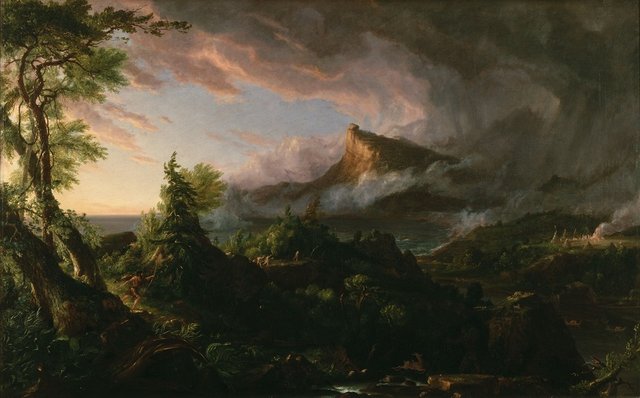
"The Course of Empire", a series of five paintings depicting an empires rise and fall, hangs in the New-York Historical Society. Painted between 1834 and 1836, all but one of the paintings measure 39 ½ × 63 ½ inches. They primarily refer to the roman empire, and they embody an idea that in their artistic execution doesn't really correspond to the power of their inspiration, but that nonetheless appear magnificent through their apocalyptic implication and understanding of the perils that threaten civilization.
Thomas Cole was born in Lancashire in England in the first year of the 19th century, but moved with his parents to Philadelphia in 1818. He received a scant artistic education and never really learned the art of drawing. But once he decided to become a painter, he managed to get prominent mentors, such as the portrait painter John Trumbull, and later on became one of the leading landscape painters of the time and founder of the Hudson River School, known for their romantic vistas of the countryside surrounding the Hudson River north of New York City.
While the European painters depictions of nature dealt with the interaction between culture and nature, Cole regarded the nature of America as a virgin world open to the painter's heavenly inspired brush. He saw nature as holy, in harmony with Emerson and the other transcendentalists in Concord. A manifestation of this approach was "Falls of the Kaaterskill", a magnificent landscape depicted in heavy, dark colors, with a native dramatically positioned on a stone shelf in the center. It was painted by a 25 year old Cole in 1826, the same year that Fenimore Cooper's novel "The last of the Mohicans" was published.
When Cole had the opportunity to set out on a "Grand Tour" to Europe in 1829, the poet William Cullen Bryant paid tribute to him in a sonnet:
"Thine eyes shall see the light of distant skies:
Yet, Cole! thy heart shall bear to Europe's strand
A living image of thy native land,
Such as on thy own glorious canvass lies.
Lone lakes--savannahs where the bison roves--
Rocks rich with summer garlands--solemn streams--
Skies, where the desert eagle wheels and screams--
Spring bloom and autumn blaze of boundless groves.
Fair scenes shall greet thee where thou goest--fair,
But different--every where the trace of men,
Paths, homes, graves, ruins, from the lowest glen
To where life shrinks from the fierce Alpine air.
Gaze on them, till the tears shall dim thy sight,
But keep that earlier, wilder image bright."
In Europe he met leading artists such as Constable and Turner and painted a lot of Italian landscapes.
In 1832 Cole returned to the United States, now with more mature personal views on American culture. He was nostalgic and skeptical of the faith in progress that reigned in his country. He saw the increasing hunger for profit as a curse, and in a poem he imagined how every hill, every valley had become a temple to Mammon, an object of people's idolatry, although they ultimately became its victim. It was now that he began on his most important work, "The Course of Empire," which occupied him from 1834 to 1836. Its five different parts got the titles "The Savage State", "The Pastoral or Arcadian State", "The Consummation of Empire", "Destruction" and finally "Desolation". Coles cultural vision is lucidly formulated in the five titles.
In "The Savage State" Cole shows the unspoiled nature of the prehistoric man: a mountain crag, a forest, a bay, within a given landscape that becomes a theme through all the five paintings. Here the hunt is the main task, and you see a man clad in hides chasing a deer wounded by an arrow. There are also men in simple boats that glide over the water, simple huts as in the native American culture, and there are men and women dancing around a fire. The first onsets towards a society are clear, with the production of houses, boats, weapons, and with the emergence of song and dance. It's sunrise, in the spring.
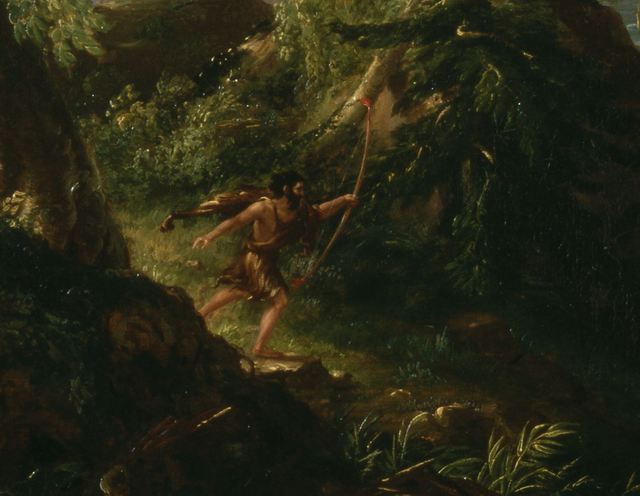
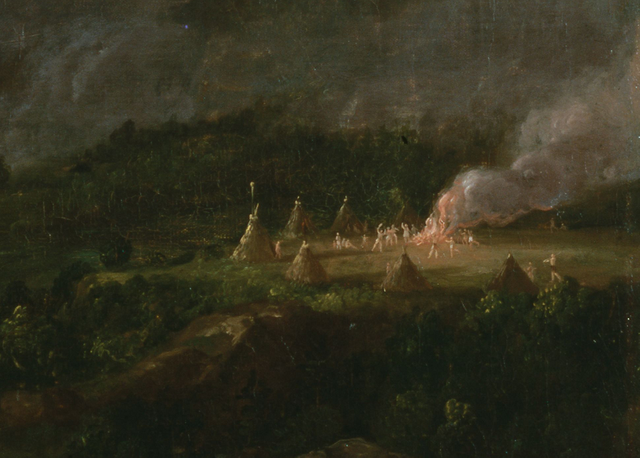
The second painting in the series, "The Pastoral State", provides a representation of a simple, Arcadian ideal state in human history. Farewell to the primitive: here we see ploughmen with farmland, shepherds with their flock of sheep. People are trading, a stone temple is erected, somewhat reminiscent of Stonehenge. An old man is drawing in the sand, perhaps in an attempt to geometrical science, a woman is working with a distaff, a boy draws a stick figure warrior on a primitive bridge. In the background, a group of peasants are dancing, one of them playing a flute. We see more and more traits of human culture emerging: agriculture, commerce, arts, science - progress have been made on all fronts. It's a few hours after sunrise, in the beginning of summer.
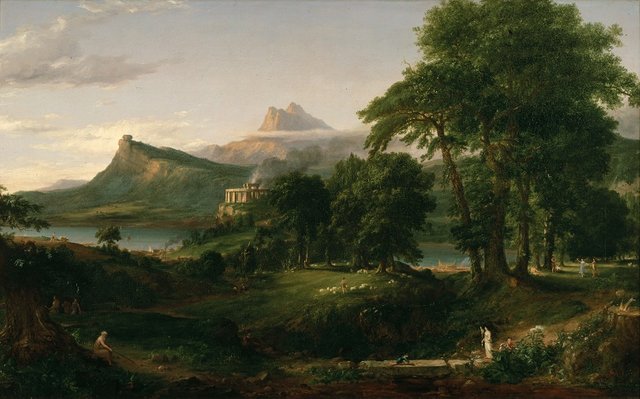
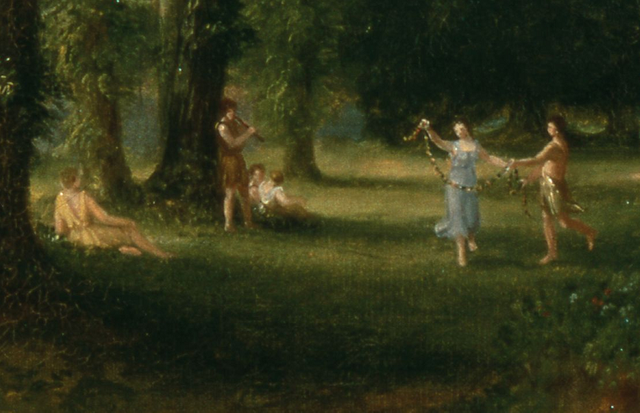
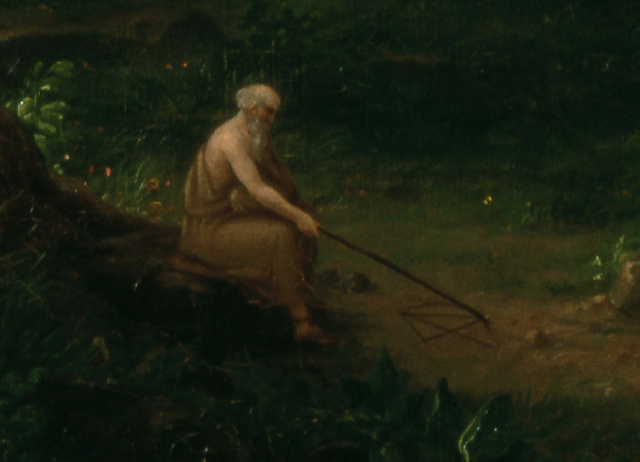
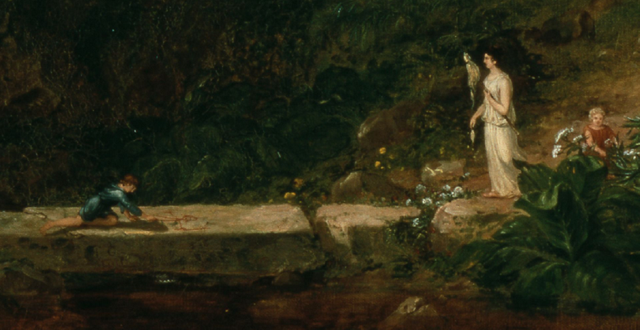
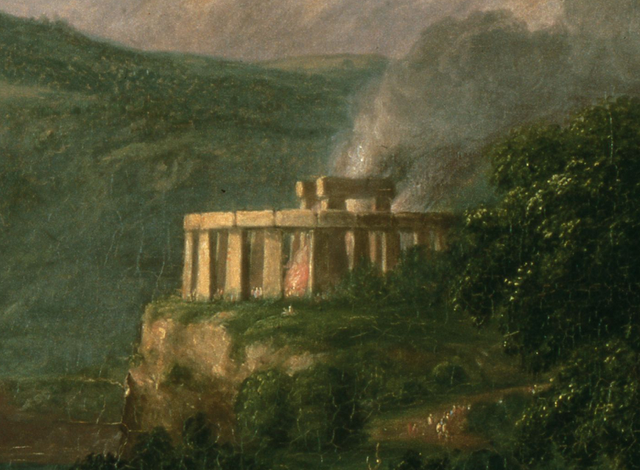
The third of painting, "The Consummation of Empire", depicts a triumphal procession in the town at the bay, where the victor in a war is hailed with garlands and cheers of his people. He's dressed in a purple robe, he travels in a carriage pulled by an elephant, and he's traveling on a magnificent bridge onto a large triumphal arch. A giant statue of Minerva, goddess of wisdom, towers over the harbor. Here, people's energy, knowledge and taste collaborates to create a pinnacle of civilization. It's just before noon, early fall.
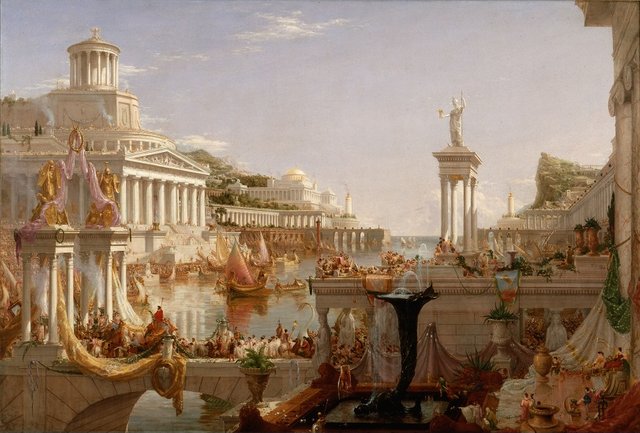
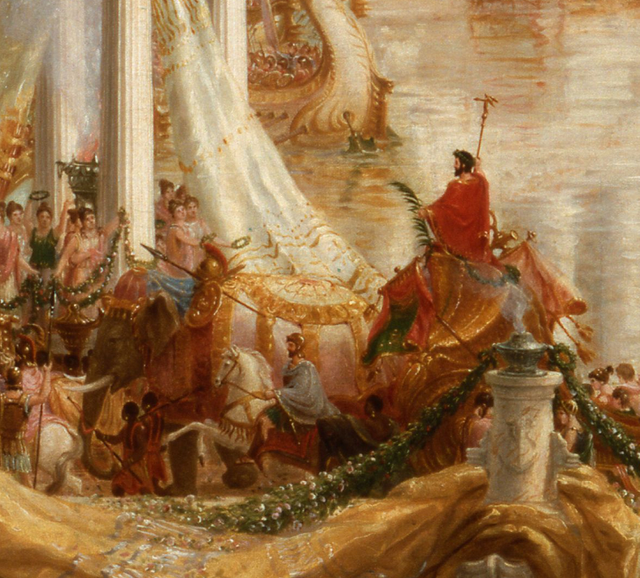
The fourth painting, "Destruction", expresses despair, perhaps because the American people's fear of the future. In an unprecedented storm walls and arcades tumble, while the temple and palace are in flames. Fierce battles rage at the damaged bridge, people and horses are thrown into the water, and the ships in the harbor goes sink. In the foreground, the dead and dying, warriors in battle among the burning buildings. A woman is grieving next to the corpse of her son, another woman is dragged away by the hair. Barbarians are about to pillage the city. Nothing but bloodshed and destruction. And finally, the fifth painting, "Desolation", depicts the same landscape as in the previous pictures, with the high mountain crag unchanged, and with the moon where the sun rose in the first image. A single pillar stands preserved in the foreground, in spite of the downfall of human civilization. At the top of the column a stork has built its nest and deer appear in front of the ruins of a Doric temple. The crowds are gone, the evening shadows fall across the landscape, it's late autumn.
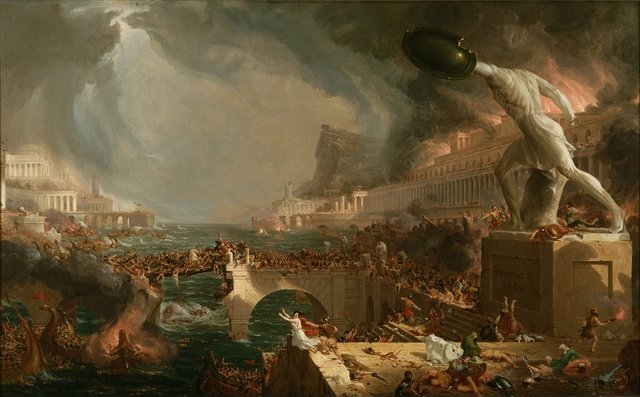
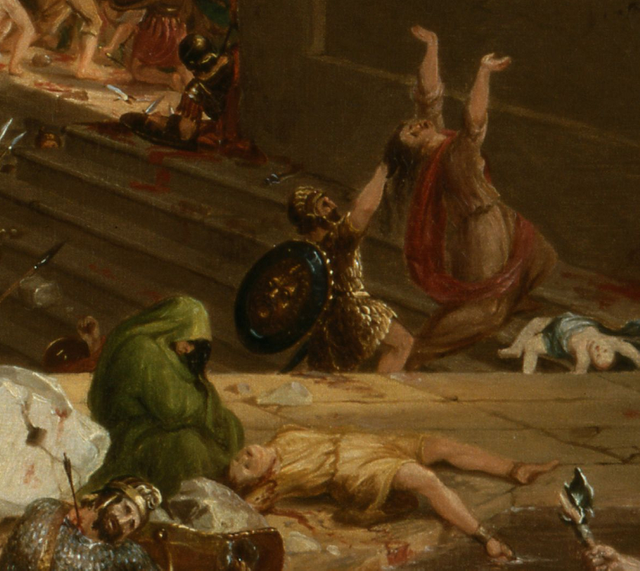
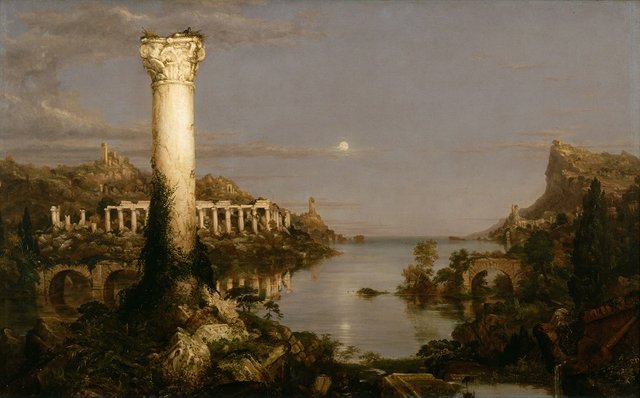
While "The Consummation of Empire" and "Destruction" were quite weak with their overburdened splendor and its eagerness to speak in an overly allegorical language, "Desolation" is a sublime and pure image of a world where destruction has ravaged but where the forces of violence have retreated, and one can discern the hope of a new culture, with the stork building its nest. Cole's suite of paintings were exhibited in New York and aroused strong admiration. In art history, he has been criticized for the overloaded motives and the lack of spontaneity. But he had raised a central topic of the time, the interest for and admiration of the Roman Republic, which they saw as a moral role model, and he expressed it with intensity and a philosophical depth.
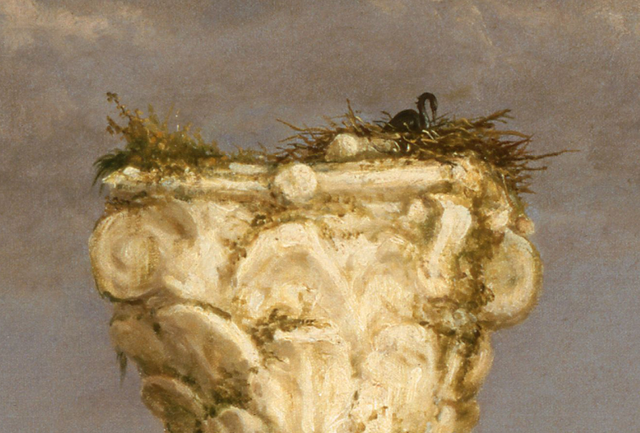
Cole was greatly inspired by 18th century cultural philosopher Edward Gibbon and his "The Decline and Fall of the Roman Empire", a work that detailed the Roman Empire during its last centuries, while criticizing the betrayal of the political and intellectual freedom that had been alive during the Republic era. Thomas Cole's premise was that of philosophy of culture. He was captivated by the development of an empire as the Roman, its strength, its culture, its way toward a culmination but also its moral downfall. At the same time, his dedication was colored by developments in the United States. He lived at a time when the country he belonged to had gained almost all parts of the North American continent. And there were many reasons to wonder about its future. Several features of the suite has a direct allusion to Cole's contemporary United States. When the victor of "The Consummation" travels on his chariot through the city, Cole refers to General Andrew Jackson, who became president in 1829 and represented a different US than what Cole wanted for his country. Jackson was a man of progress and industry, not so much a man of the pastoral landowners, and Cole feared what consequences industrialization, the railways, the conquest of the West, would have for people and nature. Moreover, he showed how the victor claimed his victims on the road to victory, and how the triumphal journey was surrounded by prisoners of war. In this great consummation Cole then included the violence that just had been caused by Andrew Jackson, as he violently put down the Creek Indians and invaded Spanish Florida. The crown of victory was drenched in blood and dishonor.
— SteemSwede (art historian, forensic psychologist & painter)
You find large enough images of the painting here, so that you can study them in detail:
The Savage State
The Arcadian or Pastoral State
The Consummation of Empire
Destruction
Desolation
Excellent post. Do you know about Byzantium?
Thank you! I do, yes. I'm quite eager to visit Constantinople, ehum, excuse me, I mean Istanbul. Have you ever been there?
No, I have not been there but like you, some day.
Unfortunately Erdogan is now busy turning all the remaining Christian churches into mosques. I hope his reign will soon be over.
Now that it has been triggered and that it's stuck in my head, I just can't resist commenting about it:
Nice read and art! All this talk about New York and ruins among nature reminds me of the Bannerman's Castle on the Pollepel Island.
great paintings
Thomas Cole was a total badass! Ans it's crazy to think how Turner use to treat his finished paintings. Sometimes he would just leave them in a corner where they would become covered with mold and mildew ;P
lol yes, his private gallery was apparently completely dilapidated towards the end and the roof windows were leaking badly